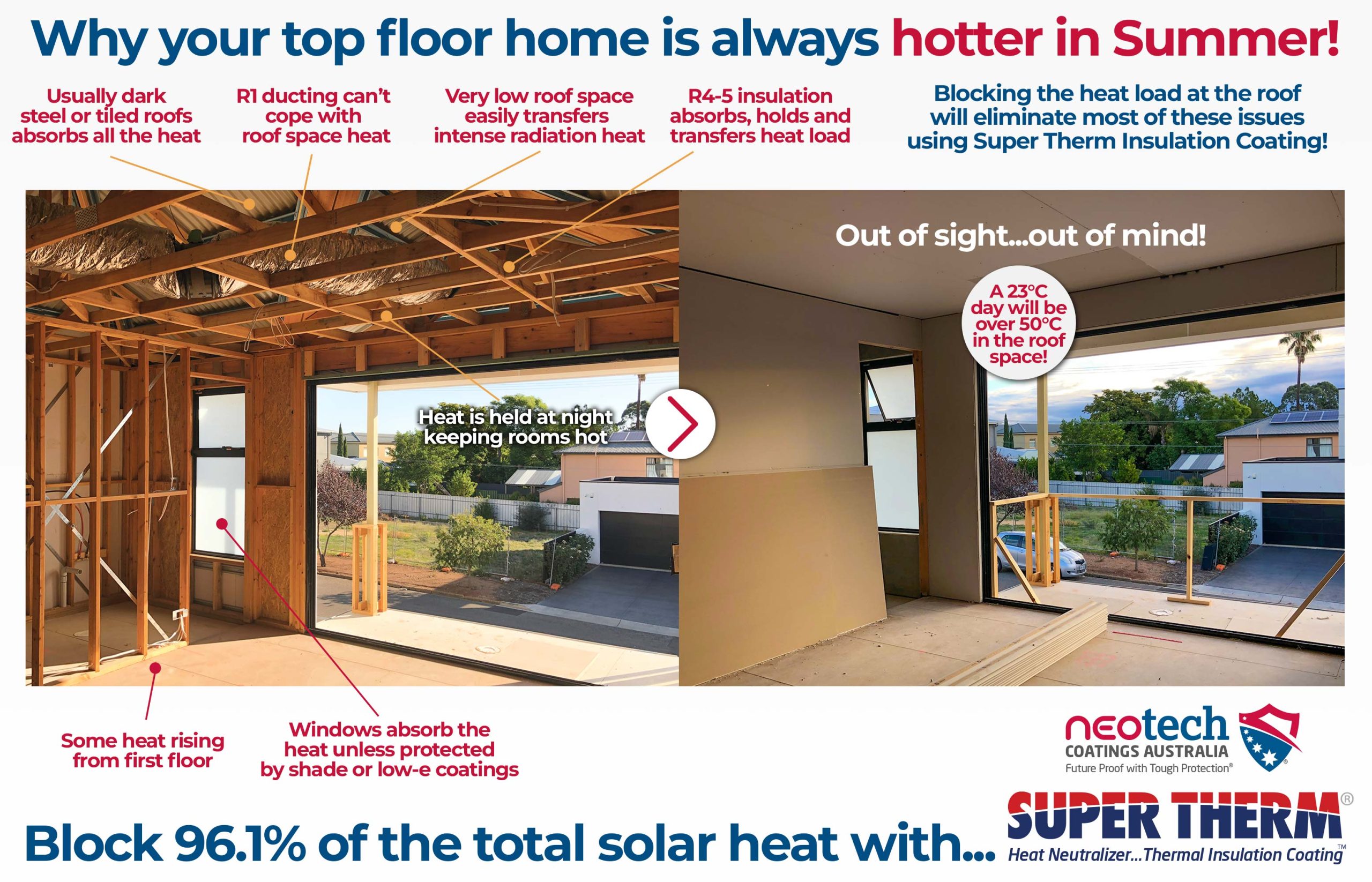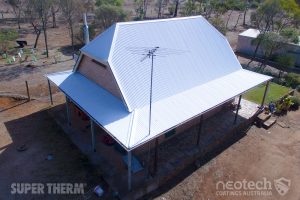How to keep your second storey cooler with an insulation coating
Owners of two-storey homes face the same problem every summer: The upstairs is hotter than the first floor. While hot air rises from the first storey, the fact that the blasting heat from the roof is also trapped in the thin roof space and the insulation putting downward heat load.

If you have high wet-bulb temperatures and high humidity this is a dangerous situation for humans…essentially making the second storey unliveable. Dark roofs can contribute to the heat buildup in a two-storey home due to the following reasons:
Absorption of sunlight on dark roofs
Dark-coloured roofs, such as those with black or dark coloured corrugated metal or tiles, have a higher propensity to absorb sunlight compared to lighter-coloured roofs. When the sun’s rays hit a dark roof, the roofing material absorbs a significant amount of solar heat. This absorbed heat can easily transfer into the roofs space or upper floors, increasing the overall temperature of the home. This is also the same for a Zincalume® roof which has low emissivity.
Heat transfer
Once the dark roof absorbs solar heat, it transfers that heat to the underlying layers, including the roof space. This transfer occurs through conduction, where heat moves through solid materials, or through radiation, where heat radiates from the roof to the surrounding areas. Consequently, if unprotected, the upper levels of a two-storey home will experience elevated temperatures due to the heat transferred from a dark roof.
Insulating the Insulation
“It was good. I haven’t used the air-conditioning yesterday or today. Been watching the inside v outside temp on the air-conditioning app. It has been below the outside consistently. I notice less heat from the ceiling.”
Client in Parkside home, Adelaide
Limited reflection
Dark roofs have lower reflectivity compared to lighter-coloured roofs. Reflectivity refers to the roof’s ability to reflect sunlight rather than absorbing it. The cool roof industry try to promote solar reflectance index saying roofs with high reflectivity, known as cool roofs, can reflect a significant portion of the sun’s rays, reducing the amount of heat absorbed by the roof and subsequently lowering the temperature inside the home.
While this is true in part, they don’t discuss the sun’s heat is made up from 3% UV, 44% visual and 53% infrared. Most cool roofs are more like warm roofs and don’t block the infrared like Super Therm®. In contrast, dark roofs reflect less sunlight and absorb most of the heat, leading to increased heat buildup.
Other reasons for heat in the second storey includes:
Heat rises
In a two-storey home, heat naturally tends to rise and accumulate on the upper floors. This is because hot air is lighter than cool air and therefore tends to move upward. As a result, the upper levels of a two-storey home can become hotter than the lower levels. However, heat is also trapped and extra heat from the roof space has gone through the insulation compounding the heat load.
Inadequate insulation
If a two-storey home is not properly insulated, heat can easily transfer between the floors. Insufficient insulation allows heat from the lower floors to rise to the upper floors, making them hotter. Additionally, poor insulation in the roof or attic can allow heat to enter the upper levels from the outside, further contributing to the heat buildup. As insulation was only ever tested at 24°C, on a 40°C day means heat can travel much faster through the bulk insulation heating up the room far quicker.
Limited air circulation
If there is inadequate airflow or ventilation in a two-storey home, it can trap hot air and prevent it from escaping. Insufficient ventilation restricts the movement of air, making it difficult for the hot air to be replaced with cooler air. This lack of air circulation can lead to higher temperatures in the upper floors. It’s a known fact that air conditioning costs double the amount over 35°C and when it’s 48°C it basically doesn’t function any more. Air conditioning ducts are only R1 so they easily allow the heat through to the cool air which is then basically not functioning. Also in many homes some ducts will run over 10m meaning that cool air becomes hotter at the end of the ducting.

Sun exposure from orientation
The orientation and design of a two-storey home can influence its exposure to the sun. If the upper levels receive direct sunlight for a significant portion of the day, they will absorb more heat. This can cause the upper floors to become hotter compared to the lower levels, especially if there are large windows or insufficient shading.
Heat transfer through windows
Windows can be a significant source of heat transfer in a two-storey home. If the windows are single-pane or poorly insulated, they can allow heat to enter the house during hot weather. The upper floors, which are closer to the sun and often have more windows, may experience more heat gain, resulting in increased temperatures. Adding a low-e window coating and shade will help this heat transfer into the top storey.
Crazy to think you’d have a dark roof in metal or tiles, little roof space and trying to push mechanical cooling into an unprotected living area. Super Therm® will block the head load from the roof into the living areas.
Cool your roof with Super Therm
Conventional roof materials absorb heat and bring it into your home. A Super Therm® cool roof blocks 96.1% of the total solar heat making your upstairs and your entire home more comfortable. If you live in a warmer climate you can retrofit with a very thin coating of Super Therm. This will block most of the heat that would otherwise warm your house and, particularly, the upstairs area.


















